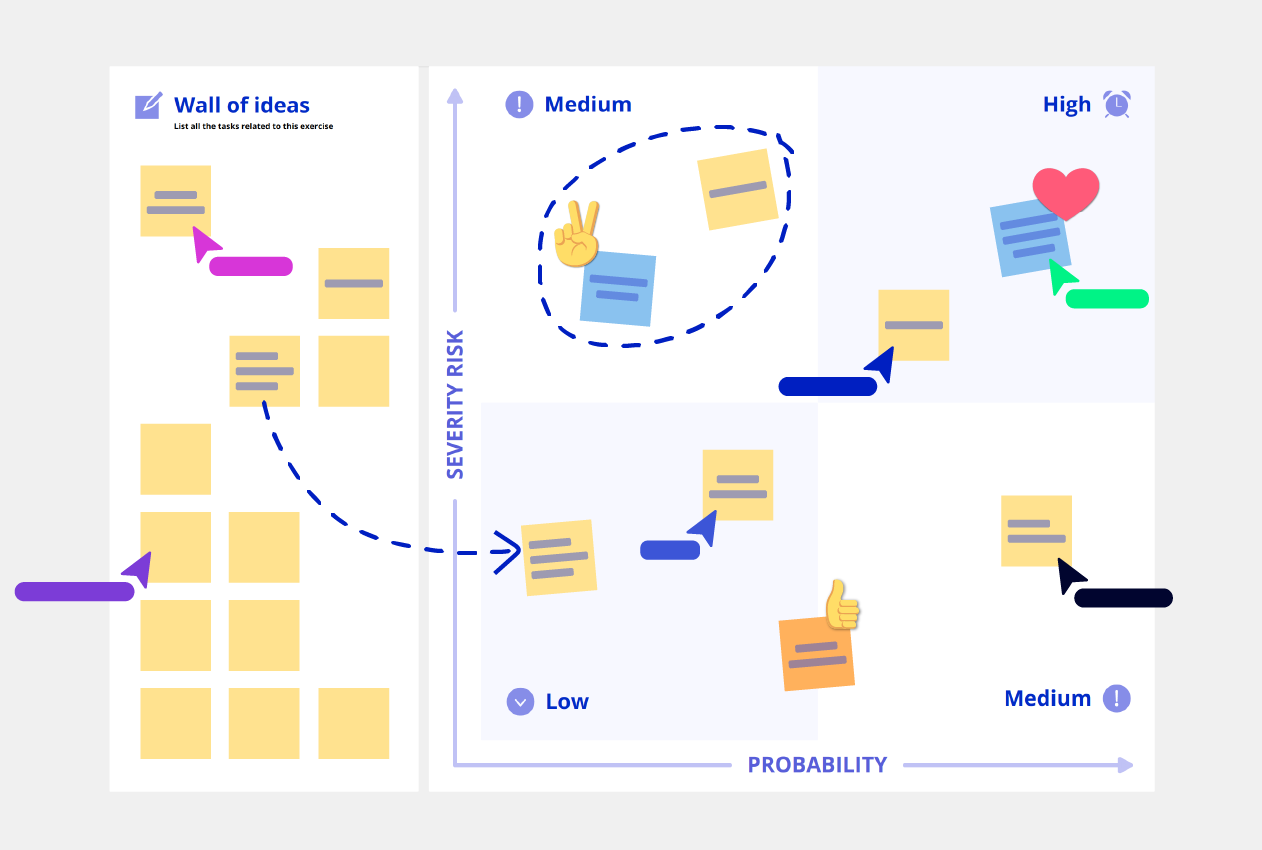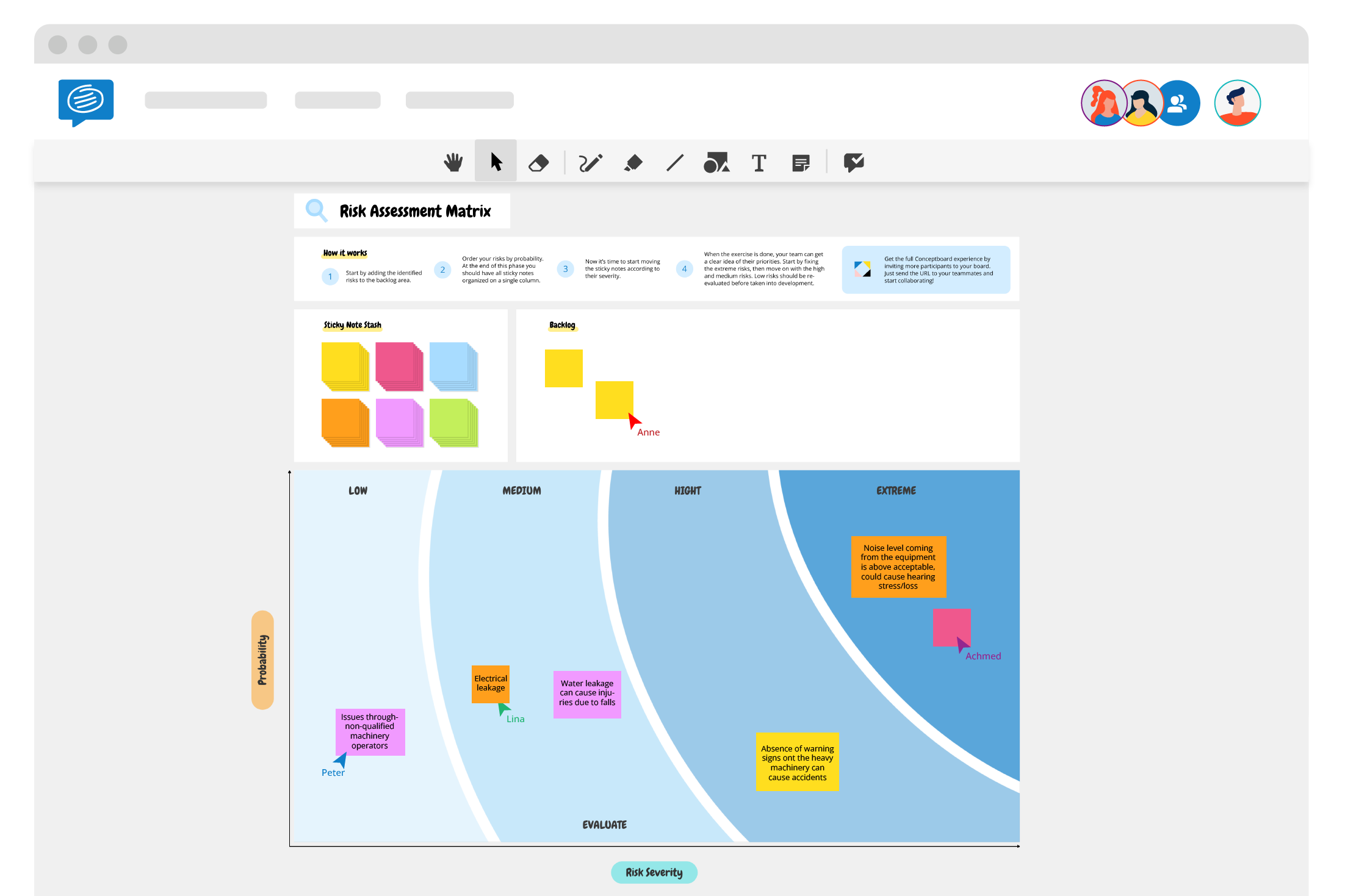How to use a Risk Matrix to manage risk
A risk matrix or business risk assessment matrix is a graph that you use to plot the probability of certain risks occurring against the impact this would have on your business. In other words, how likely is it that this identified risk will actually happen, and how severely will it affect your business if it does?

Risks are inevitable in today’s volatile marketplace. The deciding factor between overcoming and succumbing to these risks is your organizations ability to foresee and plan for them. One of the simplest and most popular risk management tools is the Risk Matrix also known as the business risk assessment matrix. We’ve created a collaborative Risk Matrix template that enables you to identify risks and assess associated likelihoods.
But first, let’s take a look at how it works.
What is a Risk Matrix?
A risk matrix or business risk assessment matrix is a graph that you use to plot the probability of certain risks occurring against the impact this would have on your business. In other words, how likely is it that this identified risk will actually happen, and how severely will it affect your business if it does?
The Risk Matrix tool works especially well because of its clear visual nature. By providing a simple visualization of potential risks, you can easily see which ones are high priority and which ones can be ignored – for now.
So where does a risk matrix fit into your project management toolbox? Let’s find out about the best time to conduct a risk assessment.
Using a Risk Matrix Template
A risk matrix template focuses on two key aspects:
- Severity: The impact of a risk and the negative consequences that would result.
- Probability: The probability of the risk occurring.
Using this free Conceptboard template will help you plot your risks according to these two aspects quickly and easily on the graph, by using online sticky-notes.

Firstly you need to decide on the severity rating for each identified risk. On the matrix, move along the x axis until you’ve reached the appropriate rating: Minor, Moderate, Significant or Severe.
Then, by moving along the y axis, assess at the probability of it happening. Starting from Unlikely: almost no possibility of this happening; then Possible: this has the potential to happen; lastly Highly Likely: risks that are bound to happen. Continue in this manner for each risk you’ve identified.
After you’ve placed each risk in the template matrix according to their severity and likelihood, you will be able to clearly see which risks require the most attention, based on their color-coded rating of the box they appear in.
- Green = Low: The consequences of the risk are minor, and it is unlikely to occur. These types of risks are generally ignored.
- Yellow = Medium: Somewhat likely to occur, these risks come with slightly more serious consequences. If possible, take steps to prevent medium risks from occurring, but remember that they are not high-priority and should not significantly affect organization or project success.
- Orange = High: These are serious risks that both have significant consequences, and are likely to occur. Prioritize and respond to these risks in the near term.
- Red = Extreme: If any risks appear in the final two red squares labelled 11 or 12, these are catastrophic risks that have severe consequences and are highly likely to occur. Extreme risks are the highest priority and need to be mitigated immediately to ensure survival of the organization or project.
It’s important to address those deemed extreme and high risk by making a response plan. Meanwhile, those risks that fall into the medium and low categories can often be monitored, but depending on your teams time and resource limits, these probably don’t need to be addressed. However, it is important to keep monitoring your risks until the project is complete.
Where distributed work happens
Streamline cross-functional team collaboration for distributed teams with Conceptboard
Creating a risk matrix for your business
The first step in creating a risk management matrix is to identify all the possible risks. It’s important to gather your project team and collaborate on risk identification. In this brainstorming session, be sure to bring historical data or documents from any from prior risk assessments your organization has completed.
As a team, you should go through this list of potential risks compiled by MindTools, and nominate any that are relevant to your situation:
- Human – Illness, death, injury, or other loss of a key individual.
- Operational – Disruption to supplies and operations, loss of access to essential assets, or failures in distribution.
- Reputational – Loss of customer or employee confidence, or damage to market reputation.
- Procedural – Failures of accountability, internal systems, or controls, or from fraud.
- Project – Going over budget, taking too long on key tasks, or experiencing issues with product or service quality.
- Financial – Business failure, stock market fluctuations, interest rate changes, or non-availability of funding.
- Technical – Advances in technology, or from technical failure.
- Natural – Weather, natural disasters, or disease.
- Political – Changes in government, tax, public opinion, government policy, or foreign influence.
- Structural – Dangerous chemicals, building design, poor lighting, falling boxes, or any situation where staff, products, or technology may be harmed.

Once you’ve got a complete list of the risks your business faces, the next step is to plot them on the matrix according to their probability and severity.
Once you’ve worked out the weight of the risks you face, as a team, or with the help of a risk manager, you can plan ways to mitigate them. This may include choosing to avoid the risk, sharing it, or accepting it while reducing its impact. Popular tools such as the Kanban board can help you structure and prioritize this workflow. Kanban’s main principle is based on matching the amount of work in progress to the team’s capacity to streamline work and maximize efficiency.
When to use a Risk Assessment Matrix?
The best time to conduct a risk assessment matrix is during the project planning phase. This way all risks will be identified before any major work begins, meaning they can also be planned for and neutralized.
A Risk Matrix assessment has other important use cases too, such as when you’re improving safety or undergoing changes or renovations in the workplace. It’s also useful for preparing a plan for possible emergency situations such as natural disasters, staff sickness or injury, or even equipment or technology failure such as power outages.
If you’d like to read more about strategic management tools, check out our other articles such as
Porter’s Five Forces Analysis,
and SWOT analysis.
Or use productivity tools such as OKRs or SMART to help you achieve your goals today!

